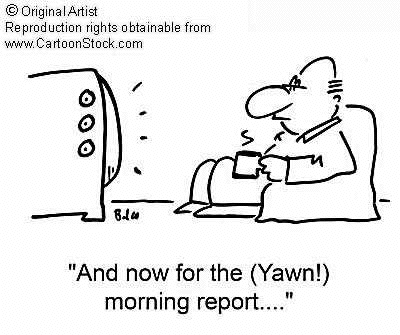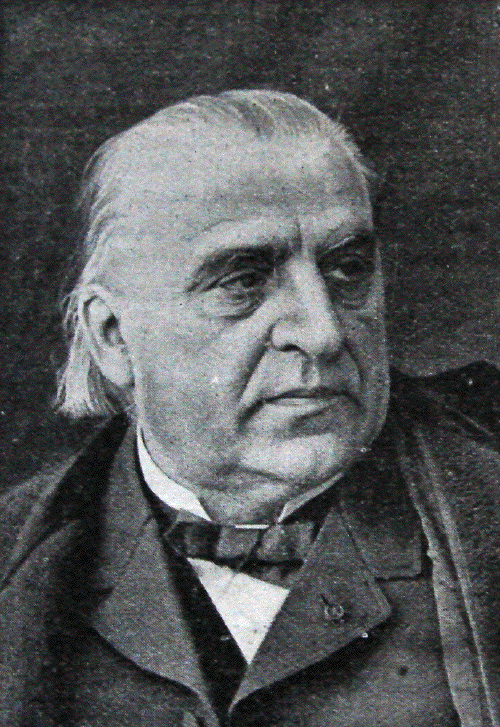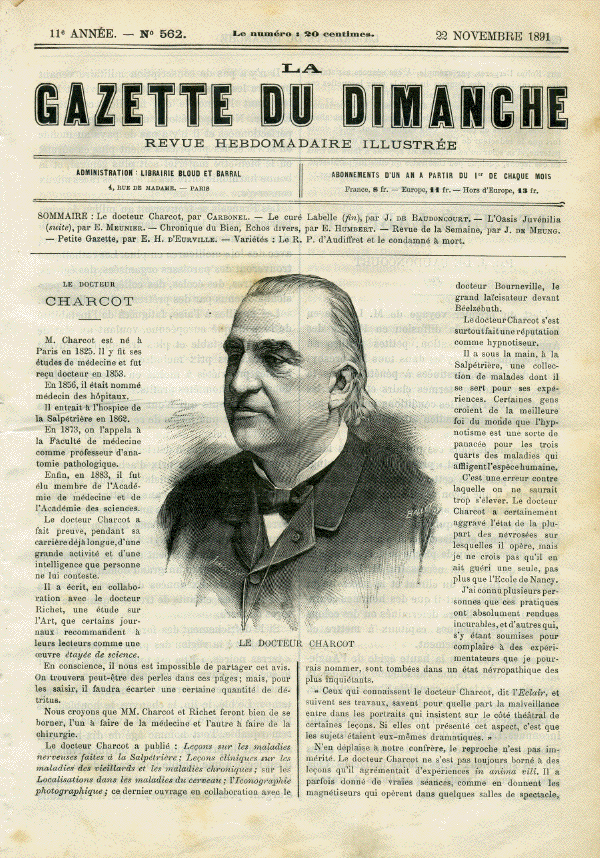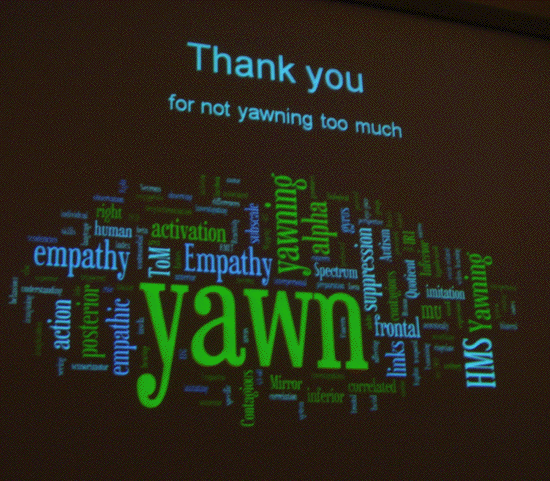
samedi 1 janvier 2011 la lettre d'information du site baillement.com N°95 Si vous ne voyez pas les images, cliquez ici pour lire cette lettre dans votre navigateur. If you cannot see pictures below, to view the email in your web browser click here baillement.com est libre d'accès, base documentaire pour comprendre, chercher, travailler
-
109 500 visitors / visiteurs - plus de 1 000 000 pages vues
-
10 th anniversary website - 10 ème anniversaire du site
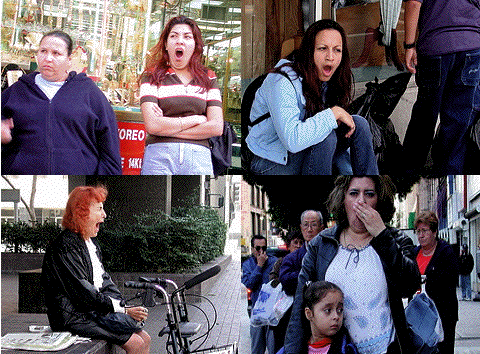
-
Peri-ictal yawning lateralizes the seizure onset zone to the nondominant hemisphere in patients with temporal lobe epilepsy - Kuba R, Musilová K, Brázdil M, Rektor I.
- Brno Epilepsy Center, First Department of Neurology, St. Anne's University Hospital and Faculty of Medicine
- Masaryk University, Brno Czech Republic
-
Bostezos y epilepsia del lóbulo temporal
- Yawning and temporal lobe epilepsy
- Bâillements et épilepsie du lobe temporal
- [Article in Spanish]
- traduction en français et son pdf
- Medrano V, Selles-Galiana MF, Fernandez-Izquierdo S, Mallada-Frechin J, Diaz-Gonzalez F, Piqueras-Rodriguez L.
- Hospital Vega Baja, Orihuela, Espana
- Revista de Neurologia
- 2005;41(1)63-64
-
- Post-ictal forceful yawning in a patient with nondominant hemisphere epilepsy
- Yankovsky A, Andermann F, Dubeau F
- Epileptic Disord
- 2006;8(1):65-69
- Yawning and seizures
-
Peri-ictal yawning - The main aim of this retrospective study was to investigate the incidence and lateralizing value of peri-ictal yawning in patients with temporal lobe epilepsy (TLE) who underwent successful surgery for epilepsy (Engel class I outcome at the 2-year follow-up visit). The authors reviewed a total of 97 patients (59 men and 38 women). Fifty-three patients had TLE arising from the nondominant temporal lobe, and 44 had TLE arising from the dominant temporal lobe. In total, they reviewed 380 seizures. Of those, 202 seizures arose from the nondominant temporal lobe and 178 from the dominant one. Peri-ictal yawning was observed in 4 of 97 patients (4.1%) and in 7 of 380 seizures (1.8%), in the postictal period in all cases. Peri-ictal yawning occurred only in patients with right-sided, nondominant TLE. It may have a lateralizing value.
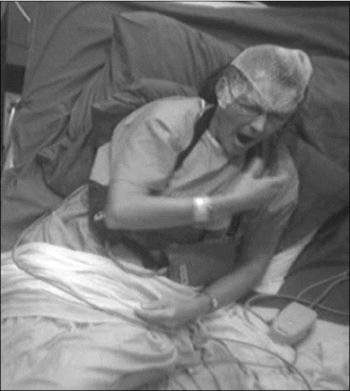
- Bâillements et épilepsie temporale
- Le but de ce travail rétrospectif a été d'examiner l'incidence et la valeur localisatrice des bâillements survenant avant ou au décours d'une crise épileptique temporale, après qu'une chirurgie ait permis la disparition des crises.
- Les auteurs ont repris les dossiers de 97 malades (59 hommes et 38 femmes). 53 patients avaient des crises temporales à partir de l'hémisphère non-dominant et 44 à partir de l'hémisphère dominant. Au total, ils ont revu 380 crises épileptiques. Parmi elles, 202 avaient leur origine dans l'hémisphère temporale non dominant et 178 dans le dominant. Les bâillements survenant après la crise furent retrouvés chez 4 des 97 patients (4,1%) et dans 7 des 380 crises (1,8%), toujours dans tous les cas, dans la periode post-critique. Ces bâillements survenaient uniquement en cas de crises temporales de l'hémisphère droit non dominant. Les auteurs suggèrent que les bâillements succédant à une crise épileptique peuvent avoir valeur de latéralisation du foyer déclenchant.
-
The dawn of the yawn: - is yawning a warning?
- linking neurological disorders
- Simon B N Thompson
- Formerly, Visiting Professor of Clinical Neuropsychology, University of Portsmouth; now at Bournemouth University, UK
- Medical Hypotheses
- 2010;75(6):630-633
- S. Thompson
- during FICY 2010
- Yawning in Diseases
- L'examen clinique du bâilleur excessif
- Inventaire des bâillements symptômes
- Yawning scale
- Questionnaire estimant les bâillements.
- Le premier Holter pour les bâillements
- Review in the Journal "Primates"
- by Akiehika Mikami
-
Linking neurological disorders and yawning - Yawning continues to pose as a scientist's conundrum. Evidence is presented of yawning and contagious yawning in a number of different neurological disorders. Explanations are discussed in the context of disparate neurological disorders together with proposals for how theses findings may be linked. Thus, greater understanding of yawning and of neurological disorders may be achieved by exploring common neurochemical pathways and the involvement of neurotransmitters that are implicated in these different disorders. Finally, contagious yawning is discussed in the context of the susceptibility of persons and the similarity this presents with our understanding of the mechanisms involved in hypnosis.

- L'avenir clinique du bâillement: est-il un clignotant auquel prêter attention en neurologie ?
- Le bâillement demeure énigmatique par
bien des côtés. Simon Thompson passe en
revue un certain nombre de désordres neurologiques
au cours desquels des bâillements surviennent. Il
discute d'explications plausibles entre des
données disparates afin de proposer des liens
explicatifs. Il suggère que la
compréhension de ceux-ci peut éclairer
l'implication des neurotransmetteurs et des voies
physiopathologiques atteintes au cours de
désordres variés. Enfin, la contagion du
bâillement est resituée dans son contexte de
susceptibilité à apparaître ce qui
lui permet d'apporter des explications aux
mécanismes à l'origine de l'hypnose.
- by Akiehika Mikami
- As seen in the chapters of this book, yawning has many aspects and it is very complex. We need to try various approaches to study yawing. I will suggest several points for future research on yawning. Yawning can be seen in all vertebrates and can be seen at the gestational age. Neural structures involved in yawning may be subcortical systems including the hypothalamus. Thus, yawning is phylogenetically and ontogenetically old behavior. However, in this book, direct comparison of yawning behavior among vertebrates is missing. I believe that it is important to study primitive vertebrates, for example reptiles. The primitive vertebrates could be a good target to study the core neural structures and the original function of yawning. It is necessary to clarify the common parts and difference of yawning behavior in lower and higher vertebrates. The correlation with sleep or sleepiness may be evident in human subjects but this kind of correlation must be tested in lower animals also. In higher animals, higher brain functions or cortical functions can be combined with the core function of yawning. It is also necessary to compare yawning behavior across species in higher animals. Contagious yawning is one possible phenomenon that appeared as a result of such integration. For this purpose, as Campbell and de Waal suggested, we need to pay attention to standardizing methods to enable comparison of different studies. To study brain functions in human subjects, it is necessary to conduct imaging studies during yawning behavior. Imaging studies using MRI, PET, or MEG are not suitable for this purpose. We should try other methods, for example EEG, MRS, or SPECT for this purpose. Anyway, this book is standing at the entrance of these studies and is a good book for gaining insight for future studies of yawning.
-
A New Book - Foreword: Barnett, H.J.M.
- Preface: Bogousslavsky, J.
- Birth of Modern Psychiatry and the Death of Alienism: the Legacy of Jean-Martin Charcot
- Bogousslavsky, J.; Moulin, T.
- Jean-Martin Charcot's House Officers at La Salpêtrière Hospital
- Walusinski, O.
- The Chair of Mental and Brain Diseases: Charcot's Pupils &endash; Benjamin Ball, Alix Joffroy and Gilbert Ballet
- Tiberghien, D.
- Édouard Brissaud, Fulgence Raymond and the Succession of Charcot
- Tatu, L.
- Great Careers: Cornil, Bouchard, Bourneville and Proust
- Paciaroni, M.; Cittadini, E.; Bogousslavsky, J.
- Keeping the Fire Burning: Georges Gilles de la Tourette, Paul Richer, Charles Féré and Alfred Binet
- Walusinski, O.
- Renewing the Fire: Joseph Babinski
- Poirier, J.; Philippon, J.
- Paul Sollier: The First Clinical Neuropsychologist
- Bogousslavsky, J.; Walusinski, O.
- Pierre Janet, Sigmund Freud and Charcot's Psychological and Psychiatric Legacy
- Pérez-Rincón, H.
- Jules Bernard Luys in Charcot's Penumbra
- Parent, M.; Parent, A.
- Hysteria after Charcot: Back to the Future
- Bogousslavsky, J.
- Jules Joseph Déjerine versus Pierre Marie
- Paciaroni, M.; Bogousslavsky, J.
- Neurology Outside Paris following Charcot
- Moulin, T.; Clarac, F.; Petit, H.; Broussolle, E.
- Birth and Death of Charcot's Scientific Journals
- Poirier, J.; Ricou, P.; Leroux-Hugon, V.
-
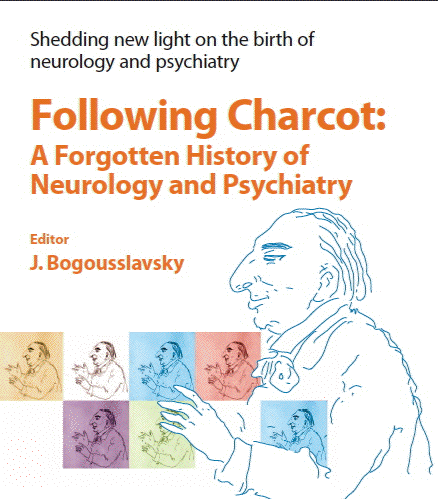
- Jean-Martin Charcot, the iconic 19th century French scientist, is still regarded today as the most famous and celebrated neurologist in the world. Despite the development of strong independent schools of thought in the USA, UK and Germany, his 'Salpêtrière' school has become symbolic of the early development and rise of neurological practice and research.
- This book presents a fresh look at the origins of nervous system medicine, and at the fate of Charcot's school and pupils. Special emphasis is placed upon the parallels and interactions between developments in neurology and mental medicine, clearly demonstrating that Charcot is not only the father of clinical neurology, but also wielded enormous influence upon the field we would come to know as psychiatry.
- Providing new insights into the life and work of Charcot and his pupils, this book will make fascinating reading for neurologists, psychiatrists, physicians and historians.
- Jean Martin Charcot, icone du scientifique français du XIX° siècle, est encore considéré de nos jours comme le plus célèbre et illustre neurologue de tous les pays. Bien que d'autres écoles se soient indépendamment développées aux USA en Angleterre et en Allemagne, l'Ecole de La Salpêtrière reste le symbole des premiers développements et des recherches sur le système nerveux, à l'aube de la naissance d'une nouvelle spécialité, la neurologie.
- Ce livre présente un nouveau regard sur les origines de la médecine du système nerveux et la destinée de l'école fondée par JM. Charcot au travers de ses élèves. Un accent particulier est mis sur les développements, à la fois parallèles et intriqués, de la neurologie et de la psychiatrie, démontrant clairement que JM. Charcot n'est pas seulement le père de la neurologie mais qu'il eut aussi une énorme influence sur l'essor de la psychiatrie telle que nous l'envisageons maintenant.
- Apportant un nouveau regard sur la vie et l'oeuvre de Charcot et ses disciples, la lecture de ce livre captivera tout autant les neurologues que les psychiatres, en fait, les médecins de toutes disciplines et les historiens.
-
- Jean-Martin Charcot
- 1825 -1893
- biographie en français
- biography in english
- Contribution à l'étude
- des bâillements hystériques
- Nouvelle iconographie de La Salpêtrière
- 1890
- La gazette du dimanche
- 28 novembre 1891 - pdf
- D'autres portraits, le cabinet de consultation, le cabinet photographique,
- une lettre manuscrite de Charcot
- Une leçon de Charcot à La Salpêtrière, tableau de M Brouillet
- Œuvres principales de Charcot
- The topography of the brain
- Forum 1886
- Magnetism and hypnotism
- Forum 1889
- Hypnotisme and crime
- Forum 1890
- La guérison par la foi
- Le Progrès Médical 1893
- Les internes de JM. Charcot
- JM Charcot et une patiente ataxique
- 1875
- la seule photo de Charcot avec un malade
-
Autres documents mis en ligne ce mois-ci :
- Review in the Journal "Primates" by Akiehika Mikami
- Bâillements et syndromes d'apnées du sommeil, le cas d'Emilie
- Bâillements, chants et relaxation le cas de Anna D
- Le bâillement, un symptôme oublié Walusinski O
- Exercitationes Medicinales ad omnes thoracis affectus decem Tractatibus absolutae Castello PV 1616
- Mademoiselle Bottard par G. Gilles de la Tourette 1898
- Marguerite Bottard (1822-1906) sa biographie et la lettre inédite de G. Gilles de la Tourette Walusinski O
- Efficacy of assessment in fetal behaviour by four dimensional ultrasonography. Kim TH, Lee JJ, et al
- Neither infants nor toddlers catch yawns from their mothers Millen A, Anderson JR
- A test of the yawning contagion and emotional connectedness hypothesis in dogs, Canis familiaris O'Hara SJ, Reeve AR
- Mouths wide open: yawning as a communicative behavior in dogs. Hoff AE
- Herding in humans Raafat RM, Chater N et al
- Yawning and thermoregulation in budgerigars: lack of support from results. de Castro Siqueira L.
- The thermoregulatory hypothesis of yawning: Time to reconsider terms such as "impossible" and "cannot" and evaluate theories based on evidence. Gallup AC
- Why do we yawn? The importance of evidence for specific yawn-induced effects Guggisberg AG, Mathis J, et al
- Warum wir gähnen ? Neues von der Chasmologie Von Marcus Schwandner SWR.de PDF
Résultats du sondageau 31 décembre 2010 Recherche par mot du site
-
Nombre de questionnaires remplis : 5056 - Combien de fois bâillez-vous par jour ? <5 = 23,6%.. 5-10 = 23,8%.. 10-15 = 15,4%.. 15-20 = 10,3%.. >20 = 26,9%
- Ressentez-vous des baillements excessifs ?
- 55,9% = non, tant mieux
- 34,6% = oui et je ne sais pas pouquoi
- 8,4% = oui et je prends des antidépresseurs
- 1,0% = oui et je prends des anti-épileptiques
- 5,9% = oui et je prends d'autres médicaments
- 2,3% = oui et j 'ai des troubles neurologiques
- 2,3% = oui et j 'ai des troubles hormonaux
- 1,5% = oui et j 'ai des tics moteurs
- 1,6% = oui et j 'ai des tocs
- déclenchez-vous facilement le bâillement d'autrui ? 74,8%
- êtes-vous sensible au bâillement d'autrui ? 70,2%
baillement.com baillement.info yawning.info écrits et réalisés par le Dr Walusinski
lire les lettres précédentes d'information du site tapez votre email - give your email pour ne plus recevoir cette lettre - to unsubscribe to the website's letter:
